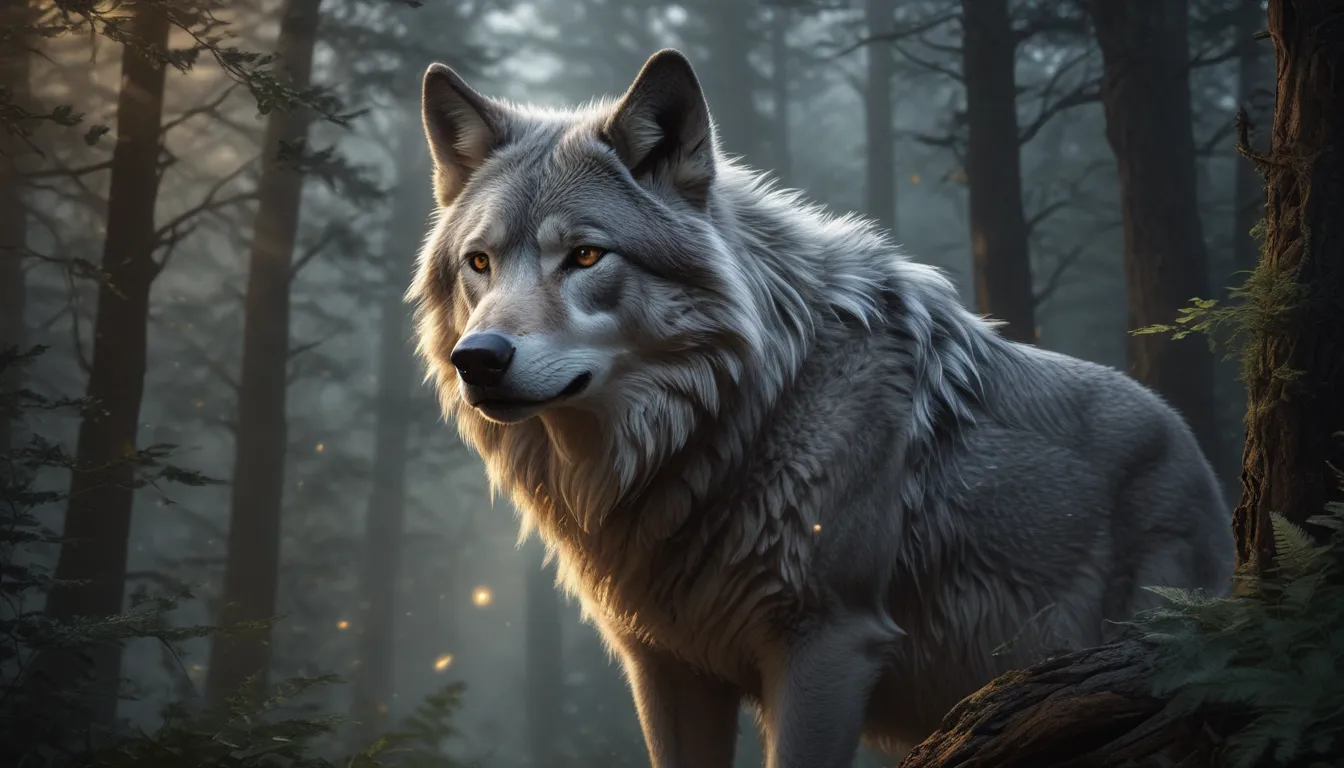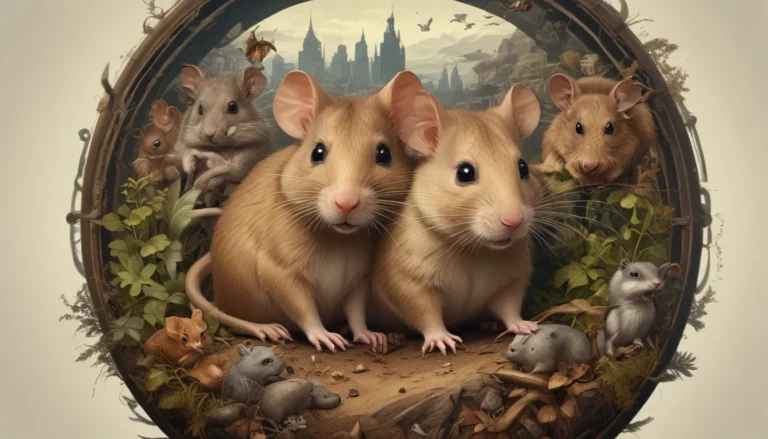The pictures we use in our articles might not show exactly what the words say. We choose these pictures to make you interested in reading more. The pictures work together with the words but don’t take their place. The words still tell you the important facts.
Gray wolves, also known as the timber wolf or western wolf, are majestic creatures that have captivated the human imagination for centuries. From their ancestral connection to domestic dogs to their role in ecosystems, gray wolves are fascinating beings worth exploring. In this enlightening article, we will delve into the world of gray wolves, shedding light on their biology, behavior, and cultural significance. Join us on a journey through the wilderness as we uncover the hidden truths about these enigmatic animals.
The Gray Wolf Is the Ancestor of the Domestic Dog
The gray wolf stands as the largest member of the canidae family and holds the prestigious title of being the ancestor of the beloved domestic dog. This remarkable connection between wolves and dogs dates back thousands of years, with evidence suggesting a shared lineage in Europe around 14,900 years ago. The resemblance between certain large dog breeds, like German Shepherds, and wolves serves as a poignant reminder of this ancestral bond. As we observe the grace and strength of gray wolves, we are witnessing a living link to our canine companions.
Not All Gray Wolves Are Gray
Contrary to popular belief, not all gray wolves sport a grizzled gray coat. Within the species, there exists a diverse array of coat colors, including black, cinnamon, brown, reddish, and pure white. This variation in fur hues adds a splash of vibrancy to the image of the classic gray wolf. During winter, their coats transform into dense, fluffy layers, shedding in spring to stay cool during the warmer months. The metamorphosis of their fur reflects the adaptability and resilience of these magnificent creatures, showcasing nature's endless creativity.
Gray Wolves Are Generally Considered to Be Endangered
Throughout history, gray wolves have faced relentless persecution, leading to a significant decrease in their populations. Once widespread across Europe and North America, they were hunted to the brink of extinction and subjected to habitat loss. Despite their endangered status in many regions, there is hope on the horizon as conservation efforts bear fruit. Recent years have seen a resurgence in wolf populations, signaling a positive shift in the tide of their conservation status. Through collective action and awareness, we can ensure a brighter future for these iconic predators.
There Are over 9000 Gray Wolves in the USA
In the vast wilderness of the United States, over 9000 gray wolves roam free, embodying the spirit of untamed nature. These resilient creatures have found a home in regions such as Canada, Alaska, the Great Lakes, the northern Rockies, and the Pacific Northwest. While challenges remain, the presence of thriving wolf populations paints a hopeful picture for their continued survival. Across Europe, smaller wolf populations dot the landscape, showcasing the enduring legacy of these magnificent predators. With careful preservation and stewardship, we can secure a harmonious coexistence with gray wolves in the wild.
Gray Wolves Are Both Hunters and Scavengers
Known for their prowess as hunters, gray wolves exhibit a multifaceted approach to acquiring food. Unleashing their hunting skills on large-hoofed mammals like caribou, moose, elk, and deer, they display a strategic and coordinated hunting behavior. Additionally, gray wolves are adept scavengers, utilizing the carcasses of deceased animals to sustain themselves. This dual strategy highlights their adaptability and resourcefulness, allowing them to thrive in diverse environments. By blending hunting and scavenging, gray wolves showcase their ingenuity in securing sustenance in the wild.
Gray Wolves Locate Prey by Scent, but Only If It’s Downwind
Guided by their acute sense of smell, gray wolves rely on scent to locate their prey. However, to effectively track down potential targets, they must catch the scent carried by the wind. Once a scent is detected, wolves engage in a stealthy pursuit, concealing themselves until the opportune moment arises. The intricate dance between predator and prey unfolds as wolves stalk their quarry, eventually closing in for the decisive chase. This delicate balance of scent, stealth, and strategy underscores the ingenuity of gray wolves in the art of hunting.
There Are 4-7 Pups in a Gray Wolf Litter
When the cycle of life continues, female gray wolves give birth to litters of 4-7 pups, marking the beginning of a new generation. The gestation period of these young pups ranges from 62-75 days, culminating in the arrival of blind and deaf cubs. Raised in the protective embrace of their pack, wolf pups learn essential survival skills and hunting techniques from their elders. As they grow and develop, these pups become integral members of the pack, contributing to the cohesion and resilience of the wolf community. Through the nurturing care of their parents and the collective support of the pack, wolf pups embark on a journey of discovery and growth.
Gray Wolves Live in Packs of 7-8 Animals
Wolves are renowned for their social nature, residing in packs that foster cooperation, communication, and unity. Within each pack, an alpha male and female assume leadership roles, guiding the group in hunting, territory establishment, and den selection. Alongside their pups and older offspring, these alpha pairs form the core of the pack, embodying the spirit of collaboration and kinship. The intricate dynamics of pack life reflect the intricate web of relationships that underpin gray wolf society, highlighting the importance of unity in the wilderness.
They Can Communicate Subtle Messages Using Body Language
In the realm of gray wolves, communication goes beyond vocalizations, extending into the realm of body language and subtle gestures. Expressive behaviors such as posture, movement, and interaction convey a wealth of information among pack members. From aggressive displays to submissive gestures, wolves utilize a diverse range of signals to navigate social interactions and establish hierarchies within the pack. By mastering the art of body language, they forge bonds, resolve conflicts, and maintain the delicate balance of pack dynamics. This non-verbal communication underscores the sophistication and emotional intelligence of gray wolves in their social interactions.
Wolf Howls Can Sometimes Be Heard over 50 Square Miles
The haunting melody of a wolf howl reverberates across the landscape, spanning over 50 square miles under favorable conditions. Wolves use howling as a means of communication, signaling to their packmates, marking territory, and coordinating activities. When howling in unison, wolves harmonize their voices, creating an ethereal chorus that resonates through the wilderness. This iconic sound serves as a testament to the unity and bond shared among pack members, evoking a sense of mystery and awe in those who hear it. The haunting beauty of the wolf howl reminds us of the wild spirit that roams the untamed lands.
A Wolf Population Is Good for the Land
In the intricate tapestry of nature, gray wolves play a vital role in maintaining ecological balance and biodiversity. By regulating deer and elk populations, wolves prevent overgrazing and habitat degradation, allowing other species to thrive. Their presence also enriches the landscape by providing nutrients through scavenged carcasses, supporting a diverse array of scavengers and decomposers. The interconnected web of life benefits from the presence of wolves, creating a healthier and more resilient ecosystem. Through their ecological stewardship, gray wolves demonstrate the profound impact of predators on the land.
European and US Wolves Speak Different Languages but Can Understand Each Other
Across continents, wolves share a common language of vocalizations that facilitate communication and coordination within packs. While European and North American wolves exhibit variations in their howls and calls, they can understand each other's messages through shared meanings and context. The universal language of wolves transcends geographical boundaries, allowing them to convey information, express emotions, and coordinate activities across vast territories. This shared communication underscores the interconnectedness of wolf populations worldwide, highlighting the intrinsic unity of these majestic predators.
Gray Wolves Mate for Life, but There Are Casanova Wolves Too
In the realm of wolf relationships, monogamy and polygamy coexist, reflecting the intricacies of pack dynamics. While some wolves form lifelong pair bonds, others engage in opportunistic mating behaviors, known as Casanova wolves. Despite the prevalence of monogamous relationships within wolf packs, the presence of Casanova wolves adds a layer of complexity to their reproductive strategies. This diverse range of social interactions and mating patterns showcases the adaptability and flexibility of gray wolves in navigating the complexities of relationships in the wild.
Gray Wolf Pups Are Fed on Their Parents Regurgitated Dinner
As nurturing parents, adult wolves provide for their young pups by regurgitating chewed-up meat for their sustenance. This unique feeding behavior ensures that vulnerable pups receive essential nutrients and care, setting the stage for their growth and development. The regurgitated dinner serves as a vital source of nourishment for wolf cubs, enabling them to thrive under the protective gaze of their parents. Through this act of parental care and provision, gray wolves demonstrate the selfless dedication and sacrifice that underpin their familial bonds.
They’ve Been Known to Use Ice to Corner Their Prey
In a display of cunning and strategy, wolves utilize icy terrain to outmaneuver their prey, herding them into strategic locations for a successful hunt. By leveraging natural features such as ravines, slopes, and thin ice, wolves corner their quarry, minimizing the risk and energy expenditure of a prolonged chase. This innovative hunting technique underscores the resourcefulness and adaptability of gray wolves in navigating diverse environments and challenges. Through their ingenuity and teamwork, wolves demonstrate the art of predation and survival in the wild.
Romulus and Remus Were Suckled by a She-Wolf
Rich in myth and legend, the story of Romulus and Remus, the founders of Rome, is steeped in the lore of a she-wolf's nurturing care. Abandoned at birth and rescued by a she-wolf, the twins were suckled and protected until their eventual rescue by a shepherd. This ancient tale epitomizes the enduring connection between humans and wolves, symbolizing the bond between civilization and the untamed wilderness. The legacy of Romulus and Remus stands as a testament to the mythical allure and cultural significance of the gray wolf in our collective consciousness.
Gray Wolves Are Partial to the Occasional Pre-match Huddle
In a display of camaraderie and unity, wolf packs engage in ritualistic behaviors before embarking on a hunt, forming a pre-match huddle of sorts. Standing in a circle, nose-to-nose, and wagging their tails, wolves display a sense of solidarity and coordination as they prepare for the hunt. This symbolic gesture reflects the bond and cooperation shared among pack members, instilling a sense of purpose and teamwork in their collective endeavors. Through these pre-hunt rituals, wolves reinforce the values of unity and collaboration that define their social structure.
Being a Werewolf Was Once a Serious Crime
Throughout history, superstitions and fears surrounding werewolves have permeated human cultures, leading to persecution and trials of individuals accused of lycanthropy. In the annals of folklore and myth, werewolves symbolize primal fears and the blurred boundaries between humans and animals. Infamous cases, such as Peter Stumpp's werewolf trial in 1589, illustrate the dark chapter of history where supposed werewolves faced torturous interrogations and condemnations. The tales of werewolves serve as cautionary fables, reminding us of the enduring fascination and dread associated with these mythical creatures.
Wolf Attacks Can Be Caused by Rabies
While wolf attacks on humans are rare, instances of aggression can occur, often linked to rabies-infected animals exhibiting unpredictable behavior. With rabies inducing violent and erratic tendencies in infected wolves, encounters with humans can turn perilous, leading to potential attacks. Despite these rare occurrences, gray wolves generally avoid human interactions, opting to steer clear of human settlements and activities. Through vigilance and education, we can mitigate the risk of wolf attacks and foster peaceful coexistence with these majestic predators.
In conclusion, the world of gray wolves is a tapestry of wonder and complexity, revealing the beauty and intricacy of nature's creations. Through their biology, behavior, and cultural significance, gray wolves captivate our imagination and evoke a sense of awe and admiration. As we journey through the wilderness alongside these magnificent creatures, we gain a deeper appreciation for the delicate balance of life and the interconnectedness of all living beings. Join us in celebrating the enigmatic world of gray wolves, where myth and reality intertwine to create a legacy of resilience, unity, and grace.
Let's embrace the spirit of the wolf and embark on a journey of discovery and wonder as we explore the mysteries of the wild. Together, we can unlock the secrets of the gray wolf and unravel the enigma of nature's most intriguing predators. Join us on this exhilarating adventure into the heart of the wilderness, where the howl of the wolf echoes through the ages, beckoning us to connect with the untamed spirit of the wild.
Embrace the Call of the Wild and Discover the Enigmatic World of Gray Wolves
As we delve into the realm of gray wolves, we uncover a world of wonder and fascination, where ancient lore meets modern science, and myths intertwine with facts. Join us on this enriching journey through the wilderness and immerse yourself in the captivating world of one of nature's most iconic predators. From their ancestral ties to domestic dogs to their intricate social dynamics, gray wolves offer a glimpse into the intricate tapestry of life on Earth. Let's embark on this exploration together and forge a deeper connection with the wild and majestic world of the gray wolf.
We invite you to join us in celebrating the spirit of the wolf and embracing the untamed beauty of nature. Through education, conservation, and awareness, we can safeguard the future of gray wolves and ensure their legacy endures for generations to come. Let's unite in our admiration for these magnificent creatures and honor their presence in the intricate web of life that sustains us all. Together, we can champion the cause of wildlife conservation and preserve the wild spirit of the gray wolf for future generations to cherish and protect. Join us on this transformative journey into the heart of the wilderness and revel in the majesty of the gray wolf.






